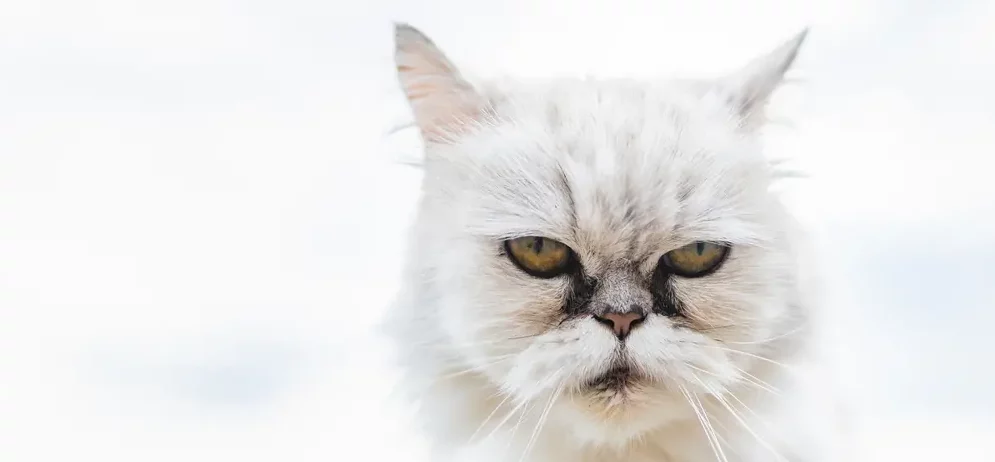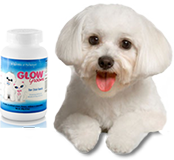Cat Tear Stains Explained
At Glow Groom, we believe that our tear stain supplement is the best product on the market to remove tear stains and prevent their occurrence for good. We also strongly encourage every cat owner to investigate the cause of their cat’s tear stains. Below, we outline why cats experience tear stains, how to remove cat tear stains, potential underlying problems, and how to control excess tear production and eliminate tear stains in the long-term.
Quick Facts About Cat Tear Stains:
- “Epiphora” describes a type of excess tear production which usually occurs in certain breeds of cats (incl. Persian or Himalayan);
- Tear staining usually appears as reddish brown streaks on your cat’s face;
- Teeth, ears, gums AND eyes should be checked regularly;
- Keep facial hair tidy and maintain hair inside the ears;
- Keep ears and eyes as dry as possible;
- Protect your cat’s eyes when shampooing.
Symptoms of a Tearing Cat
Are your cat’s eyes watering excessively? If you suspect your cat has a tear stain problem, there are several signs to look out for. Commonly, because of excess tear production, they will have wetness on their face, especially around their eyes. This can often lead to a build up of discharge, which results in reddish brown stains on their fur.
Causes of Excessive Tear Stains in Cats
It is normal for your cat to have a certain amount of moisture (tear film) on their eyes. However, tear stains are caused by excessive tear production, which is the result of several different health factors. Below, we provide a detailed outline of what these factors could be, from blocked tear ducts, to diet, to allergies or infection.
Tearing Cat
Excessive tearing and watery eyes in cats, also known as “epiphora”, is the process that creates stains on their face. Stains occur when the moisture around your cat’s eyes increases, and bacteria is able to thrive in the wet environment. This bacteria is reactive to light, and thus, when living on your cat’s face, turns a reddish brown colour.
Genetics
Cat breeds with larger eyes and shorter muzzles (Persian, Himalayan) may have insufficient tear drainage or poor eyelid function. This is because their face shape makes it difficult for tears to drain properly, hence the ongoing build-up of tear stains around your cat’s eyes.
Ear Infections
A build-up of hair in your cat’s ears can leave it vulnerable to infection. With infection comes a compromised immune system, and a greater risk of excessive tearing from a cat’s eye closest to the infected ear. To remove hair, pluck gently with tweezers or trim inside the ears with blunt-nosed scissors (used for babies’ nails). You can also ask your groomer to do it for you.
Feline Upper Respiratory Infection
Often cat tear stains are due to a cat’s watery eyes brought on by an upper respiratory infection. If your cat is displaying typical cold symptoms, similar to that of a human, such as sneezing, watery eyes and a runny nose, they are likely suffering from a cat cold or feline upper respiratory infection. Many cat colds will clear up within a week without veterinary care, however if your cat’s symptoms persist or get worse within a few days make an appointment to see your vet.
Teething
When your kitten first experiences teething, tear stains may become an issue. Often teething coincides with hair growth, which may protrude into your kitten’s eyes. This can cause irritation and excessive tearing.
As their adult teeth push through, the structure of your kitten’s face and mouth is also likely to change, placing the tear ducts under greater pressure. Consequently, excess tears may increase, even if they have had no prior existing tear stains.
In general, teeth or gum problems in cats are likely to increase the risk of tearing and stains.
Allergies
If a cat’s eyes are exposed to allergies, they may produce extra moisture to try and flush them out. Typical allergies that can affect tearing in cats may be smoke, wind, perfumes, pollen, heating and air conditioning. Try to avoid exposing your cat to these substances. Be mindful of allergens in cat-washing products, like shampoos, as this can also cause allergic reactions.
Water
In many areas, tap water has a high mineral content. If your cat drinks tap water, and splashes it around their face and eyes, the minerals in the water can stain and breed bacteria. Providing purified or filtered drinking water in a metal bowl for your cat can help with these issues. Another idea is to train your cat to drink from a dripping bottle, which can eliminate wetness from around their face and mouth.
Food
One of the best cat tear stains remedies for your pet is a balanced diet. Diet plays a big role in removing tear stains and cat eye discharge. Dry food which is free of preservatives, fillers or additives can improve their resistance to inflammatory reactions, and therefore act as one of the vital tear stain removers. Check your cat’s food for meat pulp and artificial colours, as this can stain the mouth area.
Fleas
Wetness around the face can become a breeding ground for fleas. This is because fleas need moisture to survive. With fleas, comes the tendency for your cat to scratch excessively around their facial region, which creates a greater risk of irritation and infection. Treat problems with the appropriate flea shampoo for your cat or kitten.
Blocked Tear Ducts
As we mentioned before, some breeds of cat have issues with tear drainage. And when tears aren’t draining properly, this can lead to a blocked tear duct (or ducts). Blockages will further exacerbate tear runoff, and need to be treated by a vet.
Sudden Increase In Tearing
A sudden increase in tearing, staining, and/or hair around the eyes may be a sign of “epiphora”, which is the medical term for excessive tearing. If you suspect your cat is experiencing “epiphora”, we recommend you visit your vet ASAP. “Epiphora” can influence tear flow, tear production or eye function. The treatment may vary, depending on the underlying issue. If your cat’s watery eyes don’t clear up, be sure to take them to a vet for thorough examination.
Keep Your Cat Healthy
After you ensure your cat’s overall health with the help of a veterinarian, ruling out any underlying causes of tearing and staining, you are ready to start using Glow Groom’s tear stain remedy. This will ensure the long-term nutrition and wellbeing of your cat, eliminating bacteria and tear stains at the source. Glow Groom is the best cat tear stain remover on the market, and we are proud to help felines around Australia look their shiny-bright best.



 © 2024 | Glow Groom Australia
© 2024 | Glow Groom Australia